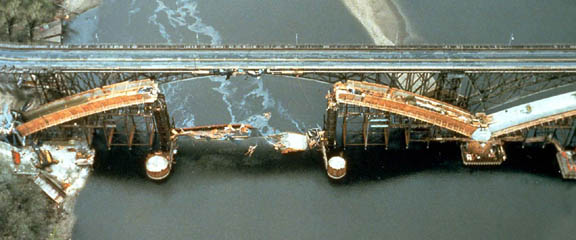Lake Street Bridge Collapse, Minneapolis, 1989
The current Lake Street Bridge replaced the previous bridge, a wrought-iron span built in 1889. The previous bridge was the second-oldest bridge in use over the Mississippi, next to the Eads Bridge in St. Louis, Missouri (built in 1874). At the time, the Minneapolis Tribune opined that the new bridge was a "foolish extravagance," since there were already seven bridges over the river. However, the Lake Street Bridge became a major connection between Minneapolis and St. Paul. Before the construction of the freeway system, it carried U.S. Route 212 over the Mississippi River.
When construction on the new bridge started in 1989, the builders built the first half of the new bridge while keeping the old bridge in service. Unfortunately, an accident ended up delaying construction. The falsework for one of the arches collapsed, causing the arch itself to collapse and killing a construction worker. Later, when it came time to demolish the old bridge, crews tried to take it down with explosives, but the first effort didn't bring the bridge down. It took another, more powerful batch of explosives to bring the old bridge down a few weeks later.
35W Bridge Collapse in Minneapolis
The eight-lane bridge on Interstate 35W, part of a major artery between Minneapolis and St. Paul, was being repaired at the time, and a witness told MSNBC that he had heard a jackhammer being used on the roadway just before the collapse about 6 p.m. Central time. Witnesses said the bridge, which was built in 1967, collapsed in three sections, sending a plume of smoke 100 feet into the sky.
The collapsed section of the bridge, which was about 1,000 feet long, had been supported by a steel structure.
Divers and rescue boats continued to search the river and the twisted wreckage of the bridge, with darkness setting in and rain beginning to fall. The Minneapolis Star Tribune said some people were seen floundering in the river, calling for help.
Theodore Roosevelt’s Roast Suckling Pig

- 1 suckling pig, about 3 weeks old, cleaned and prepared by butcher (about 10 to 12 pounds, dressed, is the best size)
- 6 cups or more, dried bread crumbs
- 3 teaspoons salt
- 1 tablespoon powdered sage
- 3 tablespoons butter
- 1 medium-sized onion, minced
- 1 tart apple, peeled and grated
- 3 tablespoons fresh parsley
- 1 carrot or lemon or apple, to put in mouth
- cranberries
- watercress
- red cinnamon apples or spiced crabapples
For the stuffing, simmer heart and liver together with seasoning in 2 cups water, until tender. Chop fine. Sauté onion in some of the butter. Grate apple. Mix chopped heart and liver with crumbs, seasoning, apple, and onion, and moisten with stock. Fill pig with stuffing being careful not to overfill, as it will split. Sew opening together.
Insert a small block of wood in mouth to hold it open. Lower the eyelids and fasten shut. (The butcher should have removed eyeballs.) Skewer legs firmly in place, the forelegs forward and the hindlegs in a crouching position. Rub whole pig well with melted butter, dredge with flour, salt, and pepper. Cover ears and tail with foil, to prevent burning.
Place roast on rack in uncovered oven in 450°F oven for 15 minutes. Reduce heat to 325°F and roast until tender, allowing 30 minutes to the pound. Baste every 15 minutes with drippings, do not use water. For the final 15 minutes, remove foil from ears and tail.
Place roasted pig on a large platter or board. Place cranberries in eyes, a carrot or lemon or apple in mouth. Drape a garland of cranberries around the neck. Garnish platter or board with bed of watercress and/or parsley and red cinnamon apples or spiced crabapples.
-- The First Ladies Cookbook (New York: GMG Publishing, 1982), 166.





















